When I first moved to my homestead, I didn’t yet have pet rabbits.
But I noticed that the wild rabbits loved to come and eat the pansies, nasturtiums, morning glories, impatiens, and dandelion flowers that grew on my property.
I really didn’t want the buns to destroy all the pretty flowers, so I wondered what garden flowers rabbits won’t eat in an effort to rabbit-proof my property.
Some of the most popular garden flowers rabbits won’t eat are floss flowers, spider flowers, pot marigolds, snapdragons, foxgloves, lantanas, salvias, vincas, poppies, milkweeds, globe thistles, crown of thorns, lavender, red hot pokers, lenten roses, and many, many more.
Note that no flower is 100% safe from a wild or domestic rabbit since there is that one rabbit that will try any plant and rabbits may eat any garden flower if food is in short supply.
What Kinds of Garden Flowers Won’t Rabbits Eat?
I have some bad news. Unfortunately, I can’t guarantee that the garden flowers on the list are 100% rabbit-proof; that is, your pet rabbit or a wild rabbit may leave these flowers alone, but there may also be that one bun that will try a plant or flower – at least once.
If there’s a food shortage (for the wild rabbit, not your beloved bun you are caring for so diligently), you may find that the wild rabbits will eat these rabbit-resistant flowers for survival.
Some “food” is better than no food.
In general, however, rabbits will avoid garden flowers, plants, or foliage that are:
- Spiny
- Rough
- Spicy
- Strong scented
- Bitter
- Woody
- Prickly
- Leathery
Rabbits also generally don’t eat any plants or flowers that have a milky sap, as these kinds of plants are usually toxic.
15 Garden Flowers Your Rabbit Won’t Eat
So what garden flowers can you plant in your backyard and know that the area will continue to look amazing (since it’s very likely that no bun will come and have a taste)?
Here are 15 garden flowers your rabbit and wild rabbits aren’t likely to eat:
1. Floss Flowers
Scientific name: Ageratum houstonianum
Ideally grown in: USDA Zones 2-11
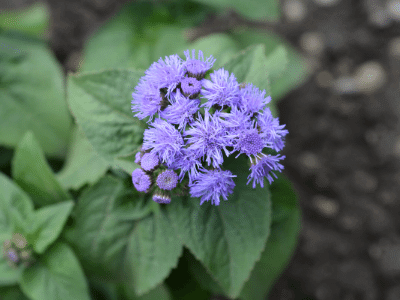
Also called bluemink, Mexican paintbrush, or blueweed, Mexican-native floss flowers resemble clusters of pompoms with their floss-like petals.
The flowers are purple-blue, but there are also red, white, and pink cultivars.
The frilliness of the flowers and the hairy leaves are off-putting to rabbits, and these garden flowers will bring color to your outdoor area.
Quick Care Tips:
- Partial shade and 6 hours of full sun
- Well-draining soil
- Water regularly so the soil stays moist
- Need a warm environment
2. Spider Flowers
Scientific name: Cleome hassleriana
Ideally grown in: USDA Zones 10-11
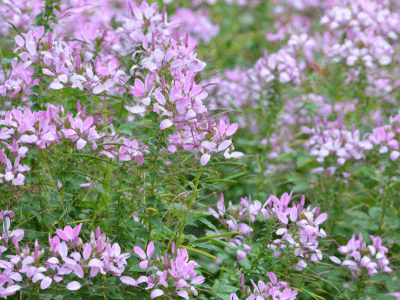
The spider flower is also called grandfather’s whiskers, pink queen, stinking clover, or spider plant.
The colors of the flower can be lavender, rose, pink, or white.
If you want to attract butterflies, hummingbirds, and hummingbird moths to your garden, then these spider flowers are ideal.
It’s easy to see why rabbits will refrain from feasting on this plant with all the long, thin stamens that resemble spider legs.
The stems are also prickly, which is something a rabbit won’t enjoy snacking on.
Quick Care Tips:
- Full and partial sun
- Well-draining soil
- Drought-tolerant once the flowering plant is established (perfect for xeriscapes)
- Need warm temperatures and high humidity
3. Pot Marigolds
Scientific name: Calendula officinalis
Ideally grown in: USDA Zones 9-11 (perennial); USDA zones 2-8 (annual)
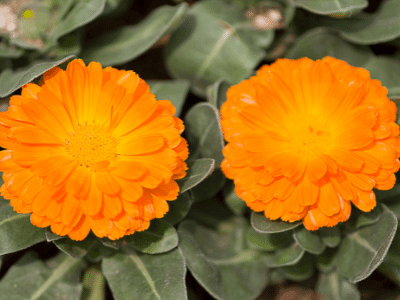
Rabbits usually destroy African marigolds, but they don’t the pot marigolds, another variety of the marigold flower family.
In warmer climates, pot marigolds, also called Scotch marigolds, Mary’s gold, or ruddles, are a perennial that doesn’t live long, while in cooler climates, the flower is grown as an annual.
Buns don’t like the daisy-like yellow, orange, cream, or pink flowers and marigold leaves because they taste bitter.
Quick Care Tips:
- Full sun and partial afternoon shade
- Rich, well-draining soil
- Occasionally water once the plant is mature
- Mild summer temperatures
Also read: Do Rabbits Eat Tomato Plants?
4. Snapdragons
Scientific name: Antirrhinum majus
Ideally grown in: USDA Zones 7-11
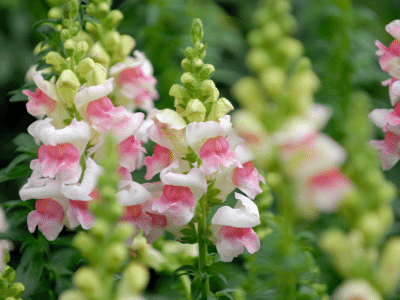
Snapdragons, also referred to as toad’s mouth, lion’s mouth, and dog’s mouth, are flowers that look like a snout or dragon’s nose.
The flower even opens and closes as pollinators enter the flower to get to the pollen, and then close again when bumblebees leave.
The flowers of a snapdragon plant come in a range of color: white, pink, red, purple, violet, orange, peach, and yellow. Your garden can truly be one of color with these dragon noses all around.
Better yet, rabbit’s don’t like snapdragons, finding these garden flowers unpalatable. Plus, some parts of the plant are toxic to buns.
Quick Care Tips:
- Full sun, partial afternoon sun
- Rich, well-draining soil
- Water the plant well when the top inch of soil is dry
5. Foxgloves
Scientific name: Digitalis purpurea
Ideally grown in: USDA Zones 4-10
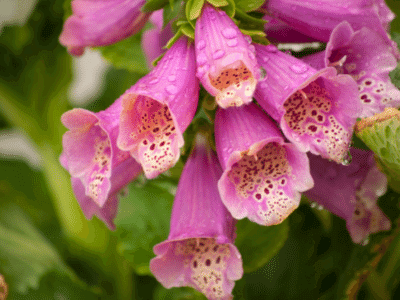
The white, pink, purple, red, and yellow tubular or funnel-shaped flowers of the foxglove plant are poisonous to rabbits and other pets.
If you have a pet rabbit, keep them away from the seeds, stems, and leaves too.
Foxgloves grow fast, but they usually only flower in their second year.
Quick Care Tips:
- Full sun and afternoon shade
- Loamy soil that drains well
- Water only when the top 1-2 inches of the soil is dry
- Prefer cooler climates and need good air circulation
6. Lantanas
Scientific name: Lantana camara
Ideally grown in: USDA Zones 9-11 (perennial), zones 2-8 (annual)
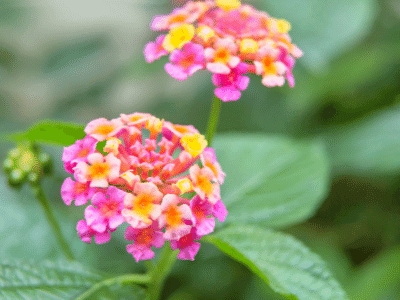
Some rabbits love to dine on lantanas; however, there are also rabbits that stay away from these garden flowers because of the stinky smell.
The foliage and berries the plant produces are also toxic to pets; the red variety is quite toxic and the white and pink variety is highly toxic.
This plant may be invasive, so check with your local extension office or municipality before planting lantanas in your garden.
For example, lantanas are invasive in Hawaii, Arizona, and Florida.
Quick Care Tips:
- Full sun (minimum 6 hours)
- Well-draining soil
- Needs frequent watering so the soil stays moist
- Loves humidity and can tolerate light frost
7. Salvias
Scientific name: Salvia
Ideally grown in: USDA Zones 3-8
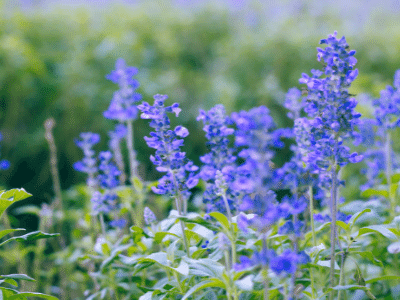
Salvia, commonly known as sage, repels rabbits because of how it smells.
And if you want to attract butterflies, bees, and other pollinating insects to your garden, then this plant is a must-have.
The flowers come in a wide range of colors, from purple and electric blue to white, pastel pink, scarlet, and magenta.
Quick Care Tips:
- Needs a sunny spot in your garden
- Well-draining soil
- Once establish, they are drought-tolerant
8. Vincas
Scientific name: Catharanthus roseus
Ideally grown in: USDA Zones 9-11
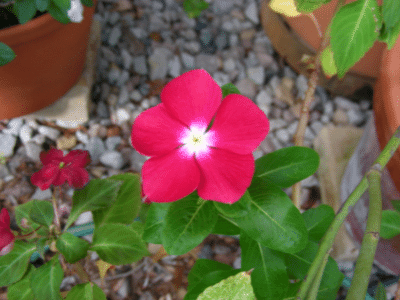
Vinca is also called Madagascar periwinkle, and the plant makes a lovely ground cover. The plant looks like impatiens, except vincas love the sun.
Rabbits are put off from vincas because of the plant’s tough stems and leathery leaves.
The plant is also toxic to rabbits, other pets, and people. Butterflies love the vinca garden flowers, and this is one reason why I planted some of these in my garden (plus, my bun won’t destroy them!).
Vinca flowers can be white, pink, red, or mauve, so if you plant all the colors, it makes for a pretty patch that contrasts nicely with the plant’s dark green leaves.
Quick Care Tips:
- Full sun with some afternoon shade
- Sandy and loamy soil
- Drought-tolerant, but it’s best to water it weekly
- Thrives in high humidity and hot temperatures
9. Poppies
Scientific name: Papaver orientale
Ideally grown in: USDA Zones 3-9
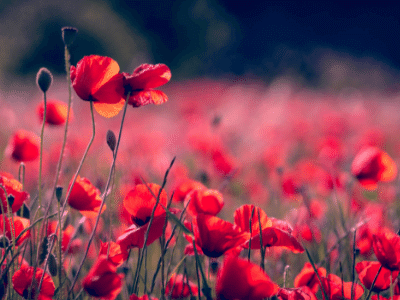
With colorful and attractive flowers that resemble crêpe paper, planting poppies in your garden adds splashes of orange, red, white, maroon, peach, pink, purple, and salmon.
The poppy plant is cold-hardy so it needs cold temperatures to thrive.
Rabbits don’t like poppy flowers because the plant is toxic, and the milky sap is off-putting.
Quick Care Tips:
- Need to be deadheaded
- Water occasionally once the poppy flower is established
- Full sun
- Well draining soil that remains moist
10. Milkweeds
Scientific name: Asclepias syriaca
Ideally grown in: USDA Zones 3-9
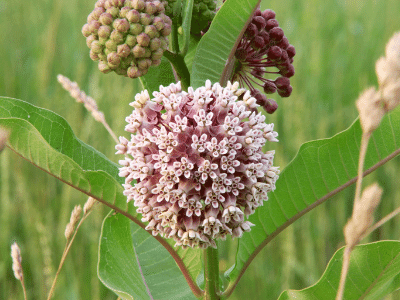
Another plant that exudes a sticky and milky sap, milkweed is also poisonous to rabbits and other pets.
Besides being a rabbit-repellent, the other reason I planted milkweed in my garden is that it attracts butterflies like the monarch butterfly.
In fact, it’s the only host plant on which a monarch butterfly can lay its eggs. The clusters of purple-pink flowers are also pretty to look at.
Quick Care Tips:
- Full sun (6-8 hours per day)
- Well-draining soil but also tolerates infertile soil and dry conditions
- Water only when the top 2 inches of soil is dry
- Doesn’t like extreme temperatures
11. Globe Thistles
Scientific name: Echinops sphaerocephalus
Ideally grown in: USDA Zones 3-9
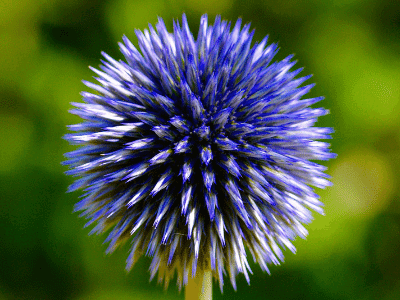
Rabbits don’t like globe thistles because of their wooly stems and hairy, spiny leaves. Plus, the spherical flowers aren’t attractive for buns either.
An essential source of nectar for bees and butterflies, globe thistles are also a host plant for painted lady butterflies.
The spherical flowers are purply-blue and give off an old-world air. I love that the globe thistles are low maintenance, making them ideal for xeriscapes.
Quick Care Tips:
- Full sun
- Dry, shallow, or rocky soil that’s well-draining
- Drought-tolerant; water new globe thistles weekly, and once established, only water when the plant shows signs of drought stress (brown leaves)
- Loves hot, dry climates
12. Crown of Thorns
Scientific name: Euphorbia milii
Ideally grown in: USDA Zones 9-11 (grow as a houseplant in colder climates)
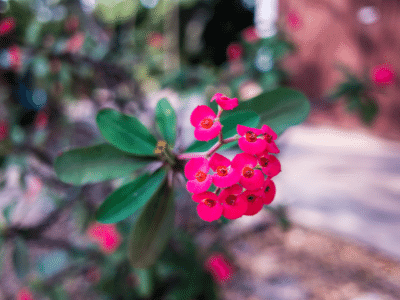
The crown of thorns, also called Christ plant or Christ thorn, is a succulent but it flowers all year round, depending on care conditions.
Rabbits don’t like this garden flower because of the spiny branches and stems, the sticky sap that’s toxic, and how it can grow into a woody shrub.
Despite the unattractive name of the crown of thorns, the succulent’s flowers can be red, white, yellow, pink, or orange.
Quick Care Tips:
- Full sun (minimum 3-4 hours) and partial afternoon shade
- Well-draining, neutral to acidic soil
- Water when the top inch of soil is dry
13. Lavender
Scientific name: Lavandula
Ideally grown in: USDA Zones 5a-9a
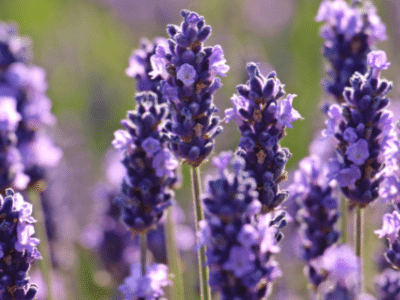
Lavender can be toxic for rabbits to consume, and because of the plant’s strong scent and taste, bunnies prefer to avoid it.
The lavender flower spikes are also something bunnies tend to avoid coming into contact with.
There are 47 species of lavender. Popular varieties are English lavender, lavandin, fringed lavender, and French lavender.
Quick Care Tips:
- Full sun (doesn’t tolerate shade well)
- Well-draining, lean soil that’s dry
- Once established, the plant is very drought-tolerant
14. Red Hot Pokers
Scientific name: Kniphofia
Ideally grown in: USDA Zones 6-9 (can grow in zone 5 with good soil drainage and mulch covering)
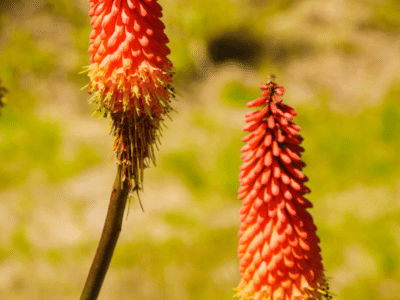
The red hot poker plant isn’t a garden flower your bun will rush to. The strong scent of the plant, together with the flower spikes, keeps rabbits away.
I like the red hot poker plant, which is also called a torch lily, torch flower, Devil’s poker, and African flame flower, because the bright red, yellow, and orange add a hint of drama to my otherwise colorful garden.
Butterflies, hummingbirds, and bees love the red hot pokers, so that’s another great reason to plant some.
However, beware that this garden flower is considered to be invasive (Oregon and California), so check with your municipality first before planting.
Quick Care Tips:
- Full sun, tolerates some afternoon shade
- Well-draining soil
- Needs deadheading to flower prolifically
- Water frequently when you’ve planted the red hot poker, and once established, water less frequently
15. Lenten Roses
Scientific name: Helleborus x hybridus
Ideally grown in: USDA Zones 4-9
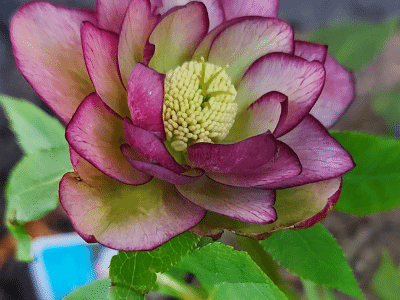
If you think a lenten rose is a rose, I’m sorry. It is actually a hybrid hellebore that’s part of the buttercup family.
The flowers are rose-like sepal buds that are traditionally pink, white, and a light rose-purple, while the cultivars can be cream, yellow, dark purple, and maroon.
Rabbits generally stay away from lenten roses because it is highly toxic and the plant is toxic to other pets, including horses, and people too.
I have a few lenten roses in my garden, and they are super easy to grow and care for.
Quick Care Tips:
- Needs partial shade
- Moist, well-draining, and fertile soil
- Only water to keep the soil moist
- Thrives in humidity
Other Flowers Rabbits Stay Away From
The 15 garden flowers I’ve included here are obviously not an exhaustive list.
I wanted to at least mention a few other garden flowers that repel rabbits:
- Yarrow
- Juniper
- Bee balm
- Ajuga
- Wormwood
- Catnip
- Sunflowers
- Begonias
- Strawflower
- Geranium
- Sweet alyssum
- Butterfly bush
- Columbine
- Hellebore
- Nicotiana
- Peony
- Russian sage
- Allium
- Anise hyssop
- Black-eyed Susan
- Zinnia
- Daffodil
- Crocus
- Iris
- Dahlia
- Lamb’s ear
- Pincushion flower
- Euphorbia
- Holly
- Jojoba
- Gooseberry
- Turpentine bush
- Lungwort
- Lupine
- Periwinkle
- Veronica
- Daylily
- Astilbe
- Baptisia
- Catmint
- Fritillaria
- Bleeding heart
- Spring snowflake
- Spanish dagger
- Lilac
- Sedum
Also read: Can Rabbits Have Salt Licks?
Final Thoughts Rabbit-Resistant Garden Flowers
I don’t like wild rabbits running through my garden, so I’ve planted quite a few rabbit-repellent garden flowers to keep them away.
So far, it’s worked, and some of the flowers I’ve planted have brought visitors in the form of bees, hummingbirds, and butterflies.
With regard to my pet bunnies, I make sure to keep them away from any garden flowers that may be toxic to them, and so far, they’ve stayed away from the flowers rabbits generally don’t eat.
I have a section of the garden where I’ve planted flowers that rabbits do like to eat so my buns can happily forage about.
Other articles you may also like:
- What to Do If a Rabbit Eats Poisonous Plants or Toxins?
- 25 Rabbit Predators (Animals that eat rabbits)
- Are Rabbits Herbivores or Carnivores?
- 27 Common Herbs that Are Good for Rabbits (and some that are not)
- 15 Easy Ways to Get Rid of Rabbits in the Garden/Yard!
- Can Rabbits Eat Money Plant?
- Can Rabbits Eat Salted Sunflower Seeds?
- Are Succulents Poisonous To Rabbits?

